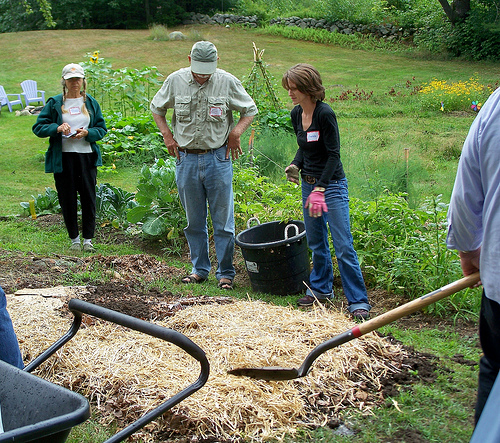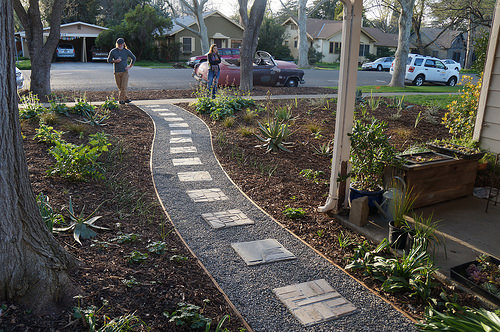What in the world are lasagna garden layers? Well, they aren’t the normal lasagna layers of pasta, cheese and tomato sauce. That’s for sure.

A wildflower garden started using this method; photo via Riddle
But this no-dig garden method — also called sheet mulching, no-till gardening or sheet composting — actually builds healthy soil over time with layers of other things, including lawn clippings, kitchen waste and newspapers. Lasagna garden fans say it’s a great way to build new beds with valuable organic matter and recycle yard and kitchen waste, without a lot of digging or tilling.
Want to give it a try? Here are some tips for building lasagna garden layers in your home garden. Let’s get cooking!

Lasagna garden materials by Young@Art
Ingredients
Before you get started, you’ll need lots of these types of ingredients:
Nitrogen layers:
- Grass clippings
- Green leafy material
- Vegetable and fruit scraps
- Coffee grounds
- Tea bags
- Egg shells
- Manure (cow, chicken, horse).
**Things to avoid: weeds, oils, animal meats, sauces.
Carbon layers:
- Dry leaves
- Dead foliage
- Cardboard
- Paper
- Pine needles
- Wood chips
- Straw
- Small twigs
**Things to avoid: dry seeds that might germinate.
Tip: Keep in mind: The smaller the pieces, the faster they will decompose.

Building a lasagna garden via mwms1916
Directions
1. About 5 to 6 months before you want to grow in this space, gather up your ingredients. Remember that sheet composting can take a while to decompose into soil. Many people start in fall for spring planting, but you can start at any time.
2. Cut your grass as short as possible.
3. Put down one sheet of cardboard or at least six pages of newspaper covering the entire garden space. Overlap edges by several inches. This layer will help smother weeds. Avoid using coated or glossy paper.
4. Wet the newspaper or cardboard completely.
5. Top this layer with about an inch of nitrogen layer.
6. Cover this layer with another inch of carbon layer.
7. Keep adding layers until it’s at least 1 1/2 feet tall. It will shrink as it decomposes.
8. Always finish the lasagna with a carbon layer. Strive for a balance of 2 parts carbon layers to every 1 part nitrogen layer.
9. Wait about 5 to 6 months, while the lasagna garden layers do their thing. The garden bed is “ready” when the layers have decomposed enough so that it looks like rich, fresh earth.
For the best lasagna gardens, consider these tips:
- In the beginning, consider covering your lasagna garden layers with black plastic to get things cooking and speed up the decomposition process.
- You’ll need a lot of raw ingredients to do these layers. Gather your grass clippings, leaves, straw and wood chips ahead of time. Start collecting kitchen waste. Ask coffee shops for used tea bags or coffee grinds; grocery stores or cafes for old vegetables and fruit.
- If your pile still is not completely ready after 5 to 6 months, you can add several inches of garden soil on top of your layers and plant in that.

One year after a sheeting mulching project; photo via UC Davis Arboretum and Public Garden
With a little patience, you can enjoy the fruits of your labor and cook up a healthy garden by using lasagna garden layers.

Share tips, start a discussion or ask one of our experts or other students a question.
No Responses to “Build Healthier Soil With Lasagna Garden Layers”